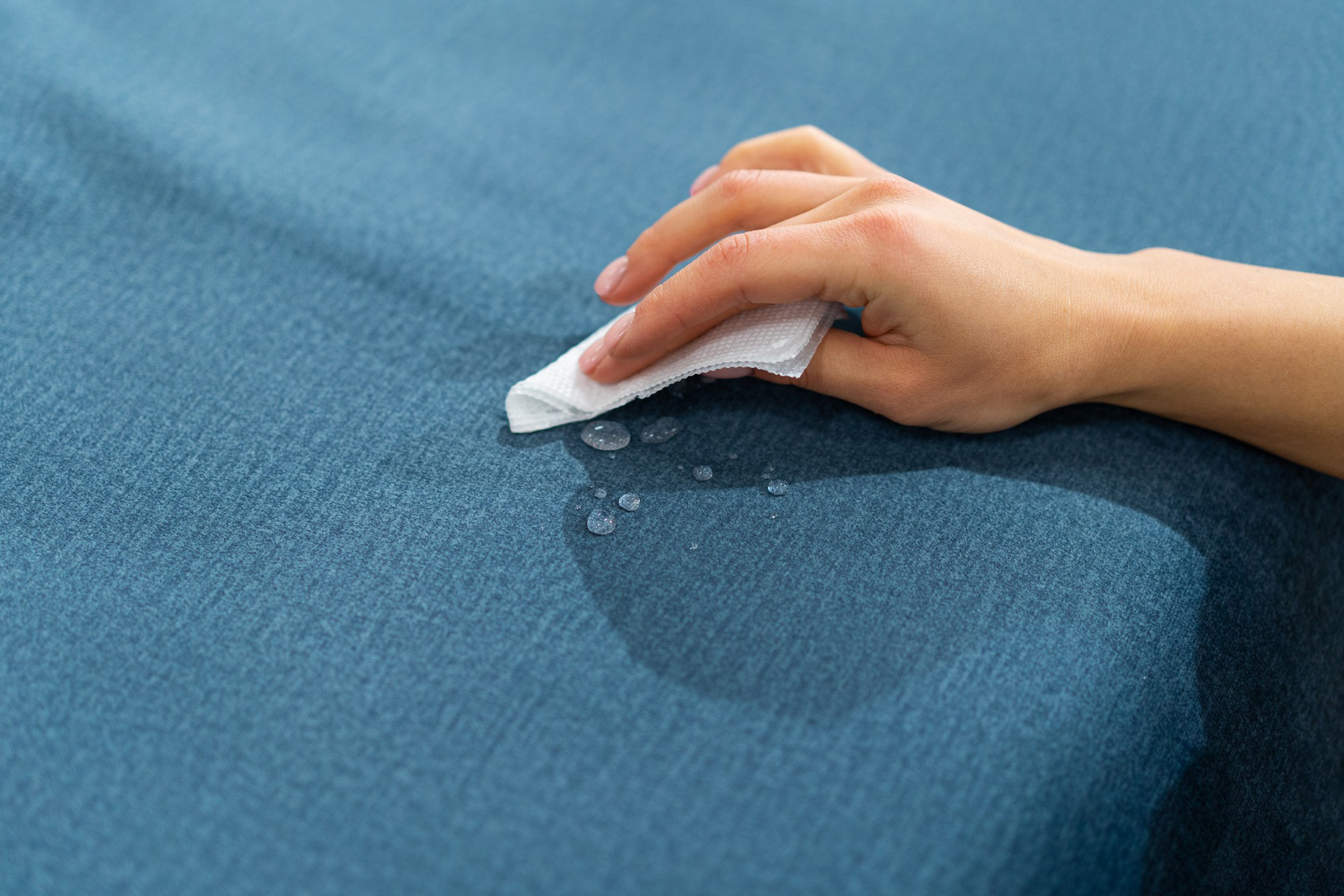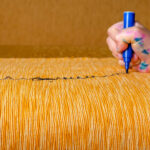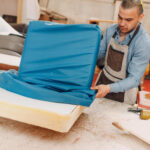How to Clean Sofa Fabric: Easy Tips to Remove Stains
Table of Contents
Cleaning a sofa fabric may seem complicated, but with the right methods and products, you can keep it in perfect condition without damaging it. In this article, you will find a step-by-step guide explaining how to clean a sofa fabric and practical and effective tips to keep your sofa free of stains, spots, and unpleasant odours. Let’s get started!
Before you start cleaning, you must identify the type of fabric on the sofa. This will determine which products and methods are safe:
• Cotton or linen: These are more delicate and require moisture care.
• Polyester or microfiber is resistant to liquids and easy to clean.
• Velvet: they require special brushing methods.
Check the manufacturer’s label, where you will find the cleaning codes:
• W: Clean with water.
• S: Dry clean only.
• WS: You can use water or dry products.
• X: Professional vacuuming only.
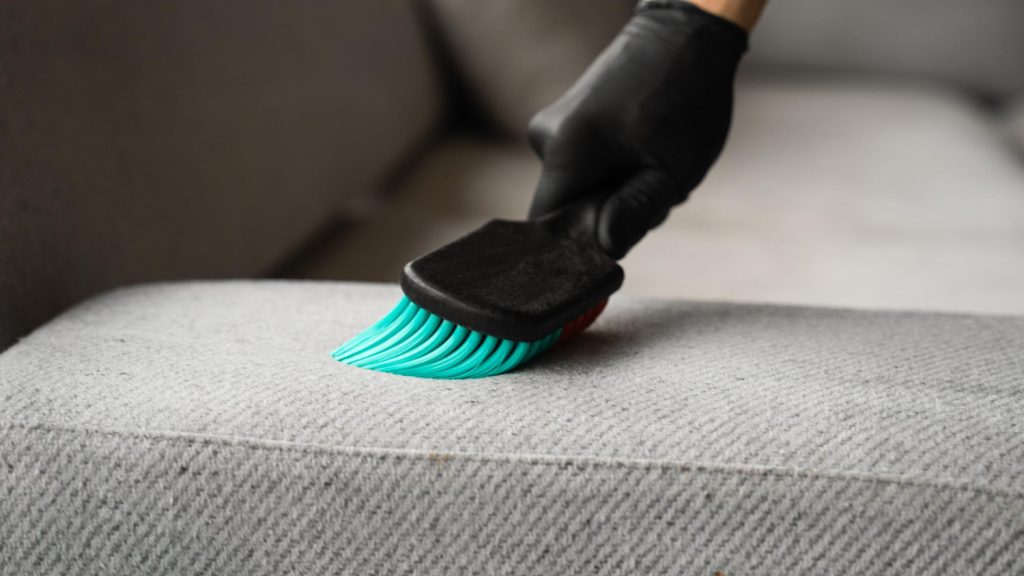
Brush the entire surface of your sofa fabric or armchair
As a result of the regular use of the sofa, it is normal for dirt to accumulate on its surface, which can come from dust, fibres from our clothing and even food residues (bread, cookies, muffins, toast, nuts).
The latter tends to accumulate, especially in the most inaccessible areas. Therefore, to clean a sofa fabric, we recommend using a brush to remove any dirt accumulated on the entire surface of the sofa or armchair, including all the most inaccessible corners we have mentioned.

Vacuum all dirt from the surface of your Sofa Fabric or armchair
Of course, after brushing the entire surface to clean a Sofa Fabric with homemade techniques, the second step is to vacuum all the dirt you have removed using a vacuum cleaner, again paying attention to the most inaccessible places. In this way, you will remove all the remaining residues so that you can apply other homemade techniques later to keep this furniture as spotless as the first day.
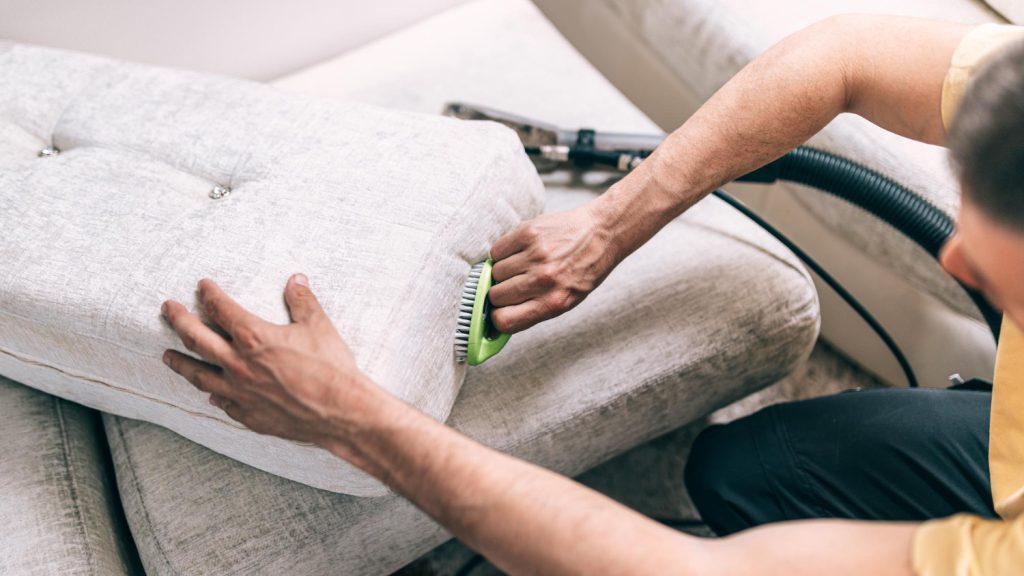
How to clean specific stains on a Sofa Fabric
Removing stains from a Sofa Fabric may seem complicated. Still, if you act quickly and use the right products, you can restore it to its original appearance without damaging the fabric. It is important to treat each type of stain specifically, as its source determines the treatment required. Improper cleaning can cause the stain to set in, spread, or damage the sofa’s fabric. Below, we will explain in detail how to deal with each type of stain and why you should use these methods.
Drink or food stains
Stains from beverages such as coffee, tea, wine, juice, or soft drinks, as well as food residue, are very common on Sofa Fabric and should be cleaned immediately so that they don’t penetrate the fibres and dry, making them more difficult to remove. When a liquid spill occurs, the fabric absorbs it quickly, so the first step is to absorb the excess substance with a clean cloth or absorbent paper without rubbing, as rubbing can cause the stain to spread deeper or stick.
After you absorb the liquid, mix warm water with neutral soap—this gentle solution won’t damage the fabric or fade its colour. Take a clean cloth, dip it in the solution, and gently rub the stained spot in a circular motion. The neutral soap helps break down organic debris without leaving a sticky residue. Finally, use a clean cloth to dry the area and leave no moisture behind.
Grease or oil stains
Grease stains from food, body oils, creams, or cosmetic products like makeup are difficult to remove because they do not dissolve in water. The best way to treat them is to use baking soda or an absorbent powder like cornstarch or talcum powder. These products can naturally pull grease particles out of fabric fibres.
To remove stains, sprinkle baking soda directly on the affected area and leave it for at least 30 minutes to absorb the grease. If the stain is recent, you can stay longer to maximize the effect. Then, using a gentle brush, remove the baking soda by blotting it with a wet cloth with water not to harm the fabric. Use diluted neutral soap or repeat the procedure if the stain remains.
Ink stain or pen mark
Ink stains or pen marks may seem permanent, but you can remove them effectively if you act quickly. Ink stains or pen marks on the fibres due to the pigments and solvents they contain, so you need a product that dissolves it without damaging the fabric. Isopropyl alcohol is the best option, as it acts as a solvent that breaks down the ink components without fading or weakening the fabric’s colour.
Put a few drops of rubbing alcohol on a clean cloth and softly rub the stained area. Start from the edges and move toward the centre so the stain doesn’t spread. It is important not to soak the fabric and to work carefully, as too much-rubbing alcohol can damage some delicate fabrics. Then, dry the cloth with a clean cloth.
Pet stains (urine, saliva, or mud)
Pet stains are particularly problematic because they leave visible residue behind and create unpleasant odours that can be permanent if not treated properly. In the case of urine or saliva, in addition to visible cleaning, neutralizing the odour and disinfecting the affected area to eliminate the bacteria that cause the unpleasant smell is necessary.
White vinegar mixed with water is an ideal solution because it has antibacterial and odor-neutralizing properties. Apply this mixture to the affected area with a spray bottle and leave it on for a few minutes. The vinegar breaks down the bacteria responsible for the odour and cleans without leaving any chemical residue.
You can blot the excess with absorbent paper if the stain is recent. For dried stains, supplement with baking soda after applying the vinegar, as this will absorb any remaining moisture and remove any remaining odours.
Blood stains
You should clean blood stains with cold water, not hot, because heat sets the blood proteins into the fibres and makes them harder to remove. Soak a clean cloth in cold water and press it against the stain to absorb the blood without rubbing. If the stain remains, make a paste with baking soda and a little water, apply it to the stained area, and leave it for 15-20 minutes. Blot with a damp cloth and repeat the process if necessary.
Red wine stains
Red wine is one of the most dreaded stains due to its high pigment content. If spilt, quickly cover the stain with coarse salt, as it will absorb the liquid and prevent it from penetrating the fibres. Wait a few minutes, then sweep away the salt and clean the spot using water, neutral soap, or a lightly soaked white vinegar cloth to help break down the wine stains.
Coffee or tea stains
You should remove coffee or tea stains quickly because they contain tannins—compounds that easily stick to fabric fibres. Start by blotting up excess liquid with absorbent paper. Then, apply warm water and neutral soap to break down the stain residue. If the stain is already dry, add a few drops of white vinegar or a little baking soda to enhance the cleaning effect.
Chocolate or ice cream stains
Chocolate and ice cream combine fat and sugar, so they need double treatment. First, scrape off excess stain with a spoon or spatula to avoid spreading the stain. Then, apply a mixture of water and neutral soap to clean the area. If any greasy residue remains, sprinkle baking soda on the surface and let it sit before brushing.
Makeup stains
Foundation, especially liquid foundation, can be tricky because it combines pigments and oils. To remove them, apply a small amount of isopropyl alcohol or neutral soap directly to the stain with a clean cloth. Rub in gentle motions and remove excess with a damp cloth. Avoid harsh products like bleach, which can fade the fabric’s colour.
These methods allow you to remove virtually any stain from your fabric sofa. It’s important to act quickly and use the right product to prevent stains or damage to the fabric. Also, always test any product on an inconspicuous area before applying it to ensure it doesn’t affect the colour or texture of the sofa.
Conclusion
A sofa is not just a place to sit; it is a small refuge to relieve daily fatigue. When you lean back on your couch with a cup of tea after work in the evening, that soft touch seems to say, “You are safe and comfortable now.”
But to maintain this comfort and warmth, taking care of the sofa is very important. Knowing how to clean the sofa fabric means not only removing stains but also prolonging the comfort and beauty of your life.
We know that in the business of life, sometimes dirt stains get on the fabric, sometimes a little guest gets a chocolate mark on their hand, and sometimes the beloved dog jumps up and smears mud on the sofa. That is why it is necessary to know the correct method for cleaning fabric properly and apply it accordingly.
Author


